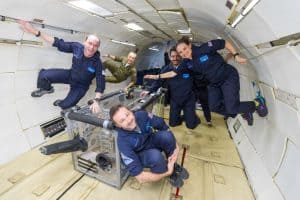PSI Research Scientist Kirby Runyon studied crater ejecta emplacement under reduced and zero gravity conditions. Runyon experienced Martian and lunar gravity as well as weightlessness on board an aircraft flying parabolic arcs over the Gulf of Mexico.
Runyon and his team used an enclosed catapult device and crushed chalk to simulate the emplacement of excavated regolith (ejecta) from an impacting meteoroid onto the Moon, Mars, asteroids, and other worlds. The aircraft flight profile provided gravity levels of Mars and Mercury (2/5th Earth gravity), the Moon (1/6th Earth gravity), and asteroids and small bodies (near-zero gravity).
The team had 20 to 30 seconds to perform one experimental run during each parabola, and repeated the experiment 29 times during the flight. They measured the width of the eject curtain, its speed, the distance it traveled, and the amount of erosion and deposition to determine how ejecta emplacement changes with varying gravity.
“We hope our results help geologists make sense of the timing and dynamics of ejecta deposition across the solar system, which is one of the most common surface geological processes. This is especially true with astronauts returning to the Moon and with so many robotic missions to small bodies,” Runyon said. “On a personal level, it feels enormously gratifying to make a scientific contribution while having a blast in reduced and zero gravity. It’s a dream come true.”

Kirby Runyon (bottom) and the science team experience a moment of weightlessness during the flight. Credit: Zero-G/Steve Boxall.
